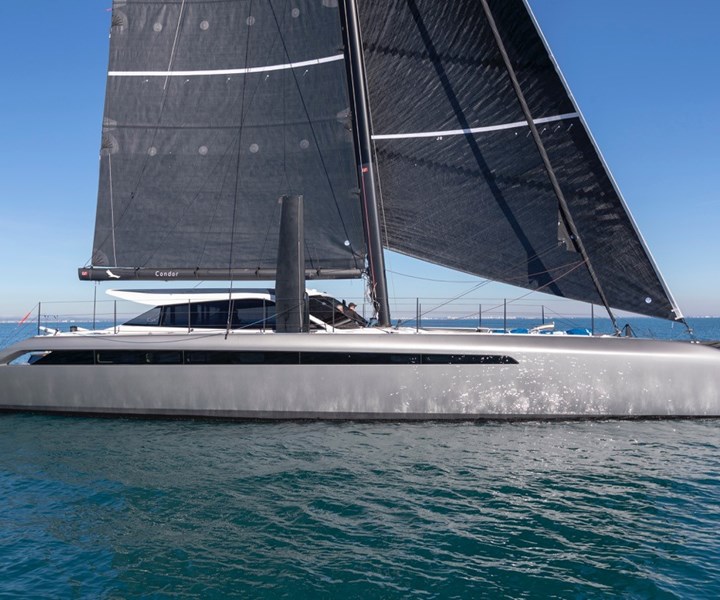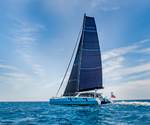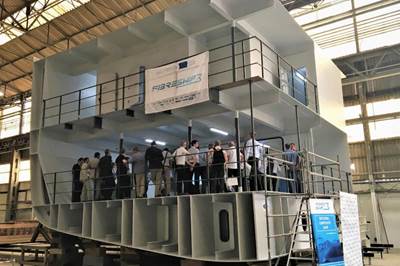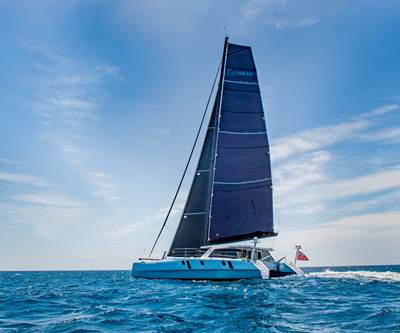
Gunboat 68 yacht. Source | Hexcel
Hexcel’s (Stamford, Conn., U.S.) latest collaboration in the marine market provides multihull builder Gunboat (Newport, R.I., U.S. and La Grande Motte, France) with a highly optimized package of carbon fiber reinforcements for its Gunboat 68 yachts.
The Gunboat brand launched in 2002, creating a new market segment by blending the seaworthiness of a blue water cruising catamaran with the performance of a grand prix racing multihull. Owned by the Grand Large Yachting Group (Tourlaville, France) since 2016, Gunboat started to develop its latest design, the Gunboat 68, at a state-of-the-art shipyard in La Grande Motte, France. Said to be sleek, fast, lightweight and ready to sail the globe, Gunboat 68 is an all-carbon-fiber catamaran crafted by composite specialists.
The first boat was launched in January 2019, and it was at this time SF Composites (Montpellier, France), part of Hexcel’s official distributor network in Europe, started to work with Gunboat and began to optimize the supply chain for series production. Hexcel and SF Composites fulfilled Gunboat’s target of identifying a supplier that could deliver the entire package of dry carbon fiber reinforcements used for the 68’s hull and deck.
The Gunboat 68 series is a complex composite structure that uses vacuum infusion for its largest components: the hull, deck and superstructure. A range of Hexcel HiMax carbon fiber multiaxials are used for these parts including 0-90 biaxials, ±45 biaxials, and infusion specific unidirectionals with aerial weights ranging from 300-800 gsm.
The first two Gunboat 68s have been launched are are crusing the world.
In addition, Hexcel’s PrimeTex spread tow woven fabric, a 300-gsm, 2x2 twill using 12K carbon fiber, is used as the first ply into the mold, providing a flatter and more uniform surface finish for the final parts, and also reducing finishing time for paint preparation.
Hexcel and SF Composites say they were able to offer Gunboat several key benefits as a single source of all dry carbon reinforcement fabrics. Their HiMax multiaxials are said to deliver high product quality consistently, and are also optimized for easy resin flow during infusion, produced in Hexcel’s dedicated carbon fiber multiaxial production unit in the U.K. Working with the Gunboat design office, Hexcel was able to offer fabrics at the exact weights required and cut to specific widths, increasing efficiency on the shop floor and keeping the overall structural weight to a minimum.
Another key requirement for Gunboat was to have a responsive and reliable supply chain; SF Composites’ warehouse is only a 30-minute drive from the Gunboat yard. With a multi-year supply contract in place, SF Composites ensures it always has a complete boat set of materials on stock.
The first two Gunboat 68s have been launched and are cruising the world, while the third, fourth and fifth are still being built, with two of them scheduled to launch this year. Hull Number six will go into production in April 2020.
HiMax materials have also been selected for all-carbon-fiber requirements on Outremer Catamarans (La Grande Motte, France), another builder of cruising catamarans that is part of the Grand Large Yachting Group.
“We demand the highest quality composite materials for our yachts, but we also look for exceptional service from our suppliers too,” says Benoit Lebizay, Gunboat managing partner. “Hexcel and SF Composites have become strong partners for us with the Gunboat 68 project, and it’s great to work with people who share our passion for delivering the very best carbon fiber products possible.”
Related Content
McLaren celebrates 10 years of the McLaren P1 hybrid hypercar
Lightweight carbon fiber construction, Formula 1-inspired aerodynamics and high-performance hybrid powertrain technologies hallmark this hybrid vehicle, serve as a springboard for new race cars.
Read MorePlant tour: Albany Engineered Composites, Rochester, N.H., U.S.
Efficient, high-quality, well-controlled composites manufacturing at volume is the mantra for this 3D weaving specialist.
Read MorePEEK vs. PEKK vs. PAEK and continuous compression molding
Suppliers of thermoplastics and carbon fiber chime in regarding PEEK vs. PEKK, and now PAEK, as well as in-situ consolidation — the supply chain for thermoplastic tape composites continues to evolve.
Read MoreWelding is not bonding
Discussion of the issues in our understanding of thermoplastic composite welded structures and certification of the latest materials and welding technologies for future airframes.
Read MoreRead Next
Removing barriers to lightweighting ships with composites
EU consortia propel large demonstrators, new technology and affordable certification.
Read MoreCarbon fiber-reinforced parts 3D-printed for catamaran
A Swiss engineering company combined 3D printing, bonding technology and carbon fiber composites to develop lighter, more efficient marine bearing cages.
Read MorePlant tour: Daher Shap’in TechCenter and composites production plant, Saint-Aignan-de-Grandlieu, France
Co-located R&D and production advance OOA thermosets, thermoplastics, welding, recycling and digital technologies for faster processing and certification of lighter, more sustainable composites.
Read More

.jpg;width=70;height=70;mode=crop)





















